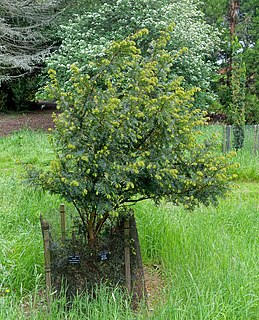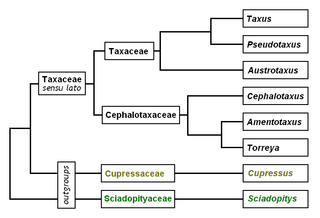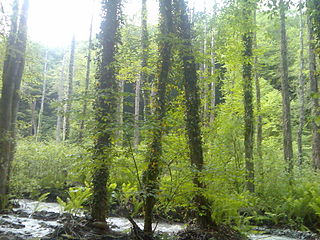
Taxus is a genus of coniferous trees or shrubs known as yews in the family Taxaceae. They are relatively slow-growing and can be very long-lived, and reach heights of 2.5–20 metres (8.2–65.6 ft), with trunk girth averaging 5 metres (16 ft). They have reddish bark, lanceolate, flat, dark-green leaves 10–40 millimetres long and 2–3 mm broad, arranged spirally on the stem, but with the leaf bases twisted to align the leaves in two flat rows either side of the stem. The oldest known fossil species are from the Early Cretaceous.

Taxus baccata is a species of evergreen tree in the conifer family, native to western, central and southern Europe, northwest Africa, northern Iran and southwest Asia. It is the tree originally known as yew, though with other related trees becoming known, it may now be known as common yew, English yew, or European yew. It is primarily grown as an ornamental. Most parts of the plant are poisonous, and consumption of the foliage can result in death.
Pseudotaxus chienii, the whiteberry yew, is a species of plant in the yew family, Taxaceae. It is the sole species in the genus Pseudotaxus, but closely related to the other yews in the genus Taxus. It is endemic to southern China, occurring in northern Guangdong, northern Guangxi, Hunan, Southwest Jiangxi and southern Zhejiang.

Austrotaxus spicata, the New Caledonia yew or southern yew, is a species of yew, the sole species in the genus Austrotaxus. It is related to the other yews in the genera Taxus and Pseudotaxus.

Taxus cuspidata, the Japanese yew or spreading yew, is a member of the genus Taxus, native to Japan, Korea, northeast China and the extreme southeast of Russia.

Taxus brevifolia, the Pacific yew or western yew, is a species of tree in the yew family Taxaceae, native to the Pacific Northwest of North America. It ranges from southernmost Alaska south to central California, mostly in the Pacific Coast Ranges, but with isolated disjunct populations in southeast British Columbia and in north to central Idaho.

Taxus canadensis, the Canada yew or Canadian yew, is a conifer native to central and eastern North America, thriving in swampy woods, ravines, riverbanks and on lake shores. Locally called simply "yew", this species is also referred to as American yew or ground-hemlock.

The Fortingall Yew is an ancient European yew in the churchyard of the village of Fortingall in Perthshire, Scotland. It is known for being one of the oldest trees in Britain, with modern estimates of its age between 2,000 and 3,000 years.

Taxus wallichiana, the Himalayan yew, is a species of yew, native to the Himalaya and parts of south-east Asia. The species has a variety of uses in traditional medicine. It is currently classified as endangered by the IUCN.

Taxus chinensis is a species of yew. It is commonly called the Chinese yew, though this term also refers to Taxus celebica or Taxus sumatrana.
The common name Chinese yew refers to either of the following three yew species:

Taxus floridana, the Florida yew, is a species of yew, endemic to a small area of under 10 km² on the eastern side of the Apalachicola River in mesophytic forests of northern Florida at altitudes of 15–40 m. It is listed as critically endangered. It is protected in reserves at the Torreya State Park and at the Nature Conservancy's Apalachicola Bluffs and Ravines Preserve, and has legal protection under the United States and Florida Endangered Species laws.

Taxus sumatrana is an evergreen shrub and one of the eight species of the yew. It is found in a number of countries, including Afghanistan, Tibet, Nepal, Sumatra, Philippines, Vietnam, India, Burma, Taiwan, and China, and is known both as the Taiwan yew and the Chinese yew. It is typically found at heights ranging from 400–3,100 m in subtropical forest and on highland ridges. It is a protected species in Taroko National Park in Taiwan.

Torreya grandis (Chinese: 香榧 is a species of conifer in either the family Taxaceae, or Cephalotaxaceae. T. grandis is a large tree that can attain height of 25 metres, and possibly as high as 39 metres. T. grandis is endemic to eastern and south-eastern China; it is found in the coastal provinces Fujian, Zhejiang, and Jiangsu, as well as in Anhui, Guizhou, Hunan, and Jiangxi inland. Its natural habitat are mountains and open valleys, often by streams, between 200–1,400 metres ASL. One common name is Chinese nutmeg yew, which refers to its edible seeds that superficially resemble nutmeg and its yew-like foliage. The seeds can be pressed for oil. The wood is used in construction and furniture, as well as in the production of high-quality go boards. T. grandis is used as an ornamental tree in Europe and North America.

The Llangernyw Yew is an ancient yew in the village of Llangernyw, Conwy, North Wales. The tree is fragmented and its core part has been lost, leaving several enormous offshoots. The girth of the tree at the ground level is 10.75 m (35.3 ft).

The Florence Court Yew is the surviving specimen of the two original Irish yew seedlings. As such, it is the oldest Irish yew alive and it is believed that almost all Irish yews worldwide descend from this specimen. It is located in Florence Court demesne in County Fermanagh, Northern Ireland and is cared for by the National Trust.

Yew is a common name given to various species of trees.

Taxine alkaloids, which are often named under the collective title of taxines, are the toxic chemicals that can be isolated from the yew tree. The amount of taxine alkaloids depend on the species of yew, with Taxus baccata and Taxus cuspidata containing the most. The major taxine alkaloids are taxine A and taxine B although there are at least 10 different alkaloids. Until 1956, it was believed that all the taxine alkaloids were one single compound named taxine.

Taxus × media, more commonly known as the Anglojap yew or simply Taxus media, is a conifer created by the hybridization of yew species Taxus baccata and Taxus cuspidata. This hybridization was thought to have been performed by the Massachusetts-based horticulturalist T.D. Hatfield in the early 1900s.

Batsara Strict Nature Reserve is a protected area in Akhmeta Municipality, Kakheti region of Georgia in Pankisi Gorge on the bank of Alazani River, 700–2,000 meters above sea level at the foot of the Greater Caucasus. It borders with Ilto Managed Reserve which includes part of Ilto valley.
















